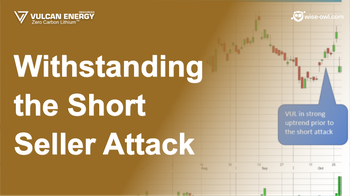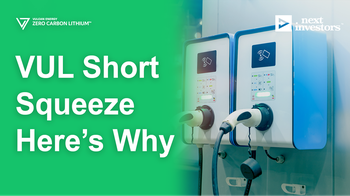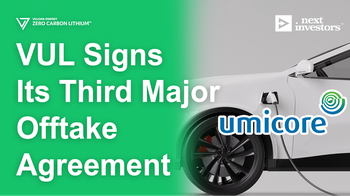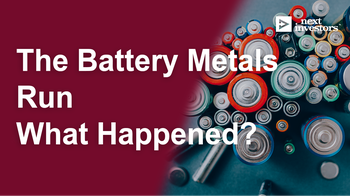VUL has performed extremely well and the management has been excellent in execution. They have delivered every promise since we invested two years ago.
Opened: 21-Dec-2021
Shares Held at Open: 563,000
What does VUL do?
Vulcan Energy Resources (ASX:VUL, FWB:6KO) is aiming to become the world’s first Zero Carbon LithiumTM producer.
VUL plans to produce battery-grade lithium hydroxide from geothermal brines pumped from wells with a renewable geothermal energy by-product.
VUL will sell its lithium product to car manufacturers looking to make Electric Vehicles (EVs) in Europe and electricity and heat energy into local markets.
What is the macro theme?
The rechargeable batteries that power EVs require lithium. And with increasing focus on decarbonisation of EV supply chains, companies that can supply the raw materials for these vehicles with low or zero carbon emissions should thrive. This has appeal for governments, ESG Funds, manufacturers and end users alike.
Why did we invest in VUL?
Excellent execution
VUL has performed extremely well and the management has been excellent in execution. They have delivered every promise since we invested two years ago.
Lots of cash in the bank
VUL raised over $320M in 2021 so we are holding to see how they will deploy this new capital.
Valuable technical skill set
Sustainable lithium from brines and geothermal is growing in popularity globally. VUL has assembled one of the best technical teams with this rare skill set, putting VUL in a strong position to grow through acquisition of geothermal\brine projects.
De-risked capital
Large pools of capital earmarked for Environmental, Social & Governance (ESG) investments need to find a home, meaning that VUL should face fewer hurdles in securing financing.
What do we expect VUL to deliver?
Objective #1: Complete Phase 1 Definitive Feasibility Study (DFS)
The major milestone of the upcoming year is completing the Phase 1 Definitive Feasibility Study (DFS), also called a Bankable Feasibility Study (BFS), which will provide further clarity on the project’s economics and development feasibility. DFS completion is expected in the second half of 2022.
Objective #2: Secure Project Financing
Having raised $320M via two Placements in 2021, VUL is financed through to completion of its DFS, but further financing will need to be secured to fund project construction.
Objective #3: Expansion of scope
VUL has already signed offtakes for all of its planned Zero Carbon LithiumTM production. We want to see the company expand its scope for future lithium production by acquiring more land holdings and more projects to help meet anticipated rising demand.
Objective #4: Heat offtake agreements
VUL is looking to sign offtake agreements in order to sell renewable heat generated from its geothermal brines into the local market.
Objective #5: More strategic partnerships (to demonstrate execution)
While VUL has already locked away much of its first five years of lithium production, it continues to develop strategic partnerships across all three of its businesses.
What could go wrong?
Development risk
The project economics are hurt by a declining lithium price or cost blow outs in the project construction. Alternatively, the flow rates from the lithium project (how much lithium comes out of their project’s wells) are slower than adequate, in turn hurting the project economics.
Market risk
It's possible the oil price takes a sharp dip on a major global economic slowdown, slowing the uptake of EV vehicles in Europe.
Financing risk
We think the DFS is going to be VUL’s calling card for financing the project, but things may change. For example, the full project currently calls for expenditure of €1.78B ($2.81B) as of the Pre-Feasibility Study (PFS). Should development risks and market risks play out this could negatively impact the level of financing. Put simply, VUL is operating in an early-stage market that could change rapidly.
Stakeholder risk
VUL needs a social licence to operate. Local landowners, business owners and community members may oppose the project’s development, either slowing down the development or preventing it altogether.
What is our investment plan?
VUL has already been a very successful investment for us since we invested at 20c in August 2019 - we have free carried, taken profit and still hold 563,000 shares.
Our plan is to continue to hold a position during 2022 and beyond. We will likely sell another 20% of our holding during the year, hopefully if the share price re-rates on the back of any significant news.
Disclosure: The authors of this memo and owners of Next Investors, S3 Consortium Pty Ltd, and associated entities, own 563,000 VUL shares at the time of writing this investment memo. S3 Consortium Pty Ltd has been engaged by VUL to share our commentary on the progress of our investment in VUL over time.
VUL continues to execute as sustainable lithium demand surges. So what’s next?
Dec 21, 2021
Dec 21, 2021 |
15 min
Our investment Vulcan Energy Resources (ASX:VUL) has delivered everything it said they would do over the two years since we first invested. Heading into 2022, the company shows no signs of slowing down in achieving dual production of renewable energy and battery quality lithium chemicals with net zero carbon footprint.

VUL Withstands Short Seller Attack
Nov 1, 2021
Nov 1, 2021 |
7 min
The attempted short seller attack on Friday last week targeting Vulcan Energy Resources (ASX:VUL) was the biggest story in our portfolio, gaining a lot of online and media attention.

VUL Short Squeeze - Here’s Why
Oct 29, 2021
Oct 29, 2021 |
9 min
Here is why we think the Vulcan Energy Resources (ASX:VUL) share price could spike UPWARDS today and close at an all time high - as a GameStop style “short squeeze” may force up to an extra $20,000,000 of BUYING in VUL IN ADDITION to its usual trading volumes.

VUL signs third major offtake in 90 days
Oct 18, 2021
Oct 18, 2021 |
14 min
Our favourite investment and 2020 Small Cap Pick of the Year Vulcan Energy Resources (ASX:VUL) just signed its THIRD offtake agreement in 90 days for its unique, environmentally friendly Zero Carbon lithium - just as the lithium price hits another new high and the global “Net Zero” movement gains pace.

Lithium price keeps rising as VUL locks in lithium production plant site
Sep 29, 2021
Sep 29, 2021 |
9 min
Vulcan Energy Resources (ASX: VUL) has secured a site for its commercial lithium hydroxide plant for its Zero Carbon LithiumTM Project, where it expects to begin commercial production of battery grade lithium hydroxide in 2024.

Successful in-house lithium extraction tech developed
Nov 14, 2022
Nov 14, 2022 |
2 min
Vulcan to expand into France
Nov 2, 2022
Nov 2, 2022 |
1 min
Highest grade lithium produced to date
Oct 25, 2022
Oct 25, 2022 |
2 min
Zero Carbon Lithium Project update
Sep 13, 2022
Sep 13, 2022 |
1 min
Direct Lithium Extraction demo plant now being built
Sep 13, 2022
Sep 13, 2022 |
1 min
The stocks hit hardest by tax loss selling
Jun 17, 2023
Jun 17, 2023 |
12 min
Here we are, the final two weeks of June tax-loss selling. Those wanting to exit a stock and holding out for newsflow or a liquidity event are probably getting to the point where time is running out.

Market Mood Swings, Price Discovery & Enterprise Value
Jun 27, 2022
Jun 27, 2022 |
26 min
Market mood swings. Down on low volumes, now up. What is price discovery? What is Enterprise Value? Current lowest Enterprise Values in our Portfolio. Cash is king. Current biggest cash balances in our Portfolio.

Share price moves on expected vs unexpected announcements
May 28, 2022
May 28, 2022 |
24 min
We invest for 1,000% gains — holding a basket of small cap stocks where we hope a couple will deliver an outsized return over time.

Why we invest in Oil & Gas and Precious Metals
Feb 21, 2022
Feb 21, 2022 |
17 min
Across our portfolios we have investments in battery metals, oil & gas, precious metals, medicinal cannabis, early stage tech, green energy, growth stocks and new energy materials.

The "Lesser Kown" Energy Transition Metals: Copper, Aluminium, Graphite, Helium, Rare Earths
Feb 5, 2022
Feb 5, 2022 |
27 min
We think this investment theme is just getting started and we’re determined to repeat that success across a range of new commodities that are critical to the “energy transition”.
